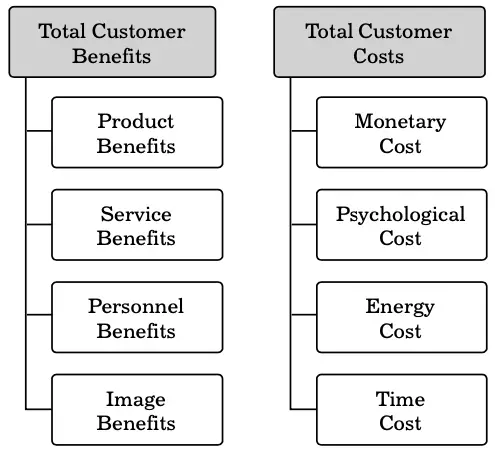What is Customer Value?
Customer Value, also known as customer-perceived value shows the difference between customers’ perceived evaluations of the benefits versus the product cost. Customer value determines whether the customer perceives enough value of the product offering in exchange for the amount he is paying for the particular product or service. The customer will regret making the purchase if he/she feels that the price of the product outweighs its benefits, especially, when the competitor is offering a better product at a lower price.
In simple equation: CV = B – C
Here,
CV means Customer Value
B means Benefits
C means Cost
Table of Content
An organisation must consider not only the price paid by the customer but also the time, effort, convenience, and energy spent in making the purchase. For each customer, benefits may vary which changes the value.
Benefits which the consumer counts from the product or service include product quality, ownership, image, organisation’s brand and affiliation, customer service and experience. Figure 3.3 shows the factors affecting customer’s perceived value:

Factors Affecting Customer’s Perceived Value
Customer’s Perceived Value
Customer perceived value is the idea that the product’s success of any business hinges on its customers’ belief that the offered product or service can satisfy their needs.
According to Philip Kotler:
Total Customer benefit – “the perceived monetary value of the bundle of economic, functional and psychological benefits customers expect from a given market offering because of the product, service, people and image”.
Total Customer Cost – “perceived bundle of costs customers expect to incur in evaluating, obtaining, using and disposing of the given market offering, including monetary, time, energy and psychological costs”.
Components Under Total Customer Benefits
Let’s understand the components under total customer benefits:
Product benefit
It includes those attributes of the product which have the ability to entice the potential consumer for selecting the offered product over others. For example, a customer may purchase an automatic car (car with auto-gear) instead of a normal car with gears.
Services benefit
It includes those attributes of the services offered such as help, instructions offered along with the product. For example, the ingredients and customer helpline numbers. For example, most mobile manufacturers offer free technical assistance for any issue related to their mobile.
Personnel benefit: It refers to the perceived values that are pro- vided by the human resource in the system, involved in the process. For instance, the sales personnel of the organisation who help the customer in making the right choice on the basis of their requirements.
Image benefit
It refers to the brand name linked with the product. For example, if a well-known company like Reliance offers a new product; it would most probably receive good sales because of the brand image that Reliance has acquired till now.
Components Under Total Customer Costs
Now let’s understand the components under total customer costs:
Monetary Cost
It includes the costs that are incurred by a customer for obtaining the product. For example, if you go to any Electronics dealer (say, Vijay Sales) to purchase a T.V.; then, your monetary cost will be the sum of the cost of the T.V. and the money you spent on travelling till Vijay Sales.
Psychological cost
It refers to the total mental effort made during acquiring and using the product from the time it was purchased moment to the moment it was consumed.
Energy Cost
It refers to the energy which a buyer spent during the whole process of purchasing the product.
Time Cost
It refers to the time invested by the buyer during the buying process. It includes the time taken for the customer to visit the store and to purchase product.
Importance of Customer Value
The key aspect of developing a profitable customer relationship is customer value. Let us understand why it is important to consider customer value:
- Prospective customers look for products that are affordable and able to fulfil their needs and wants. They are not specifically Perspective customers are searching for a particular organisation’s product or service. That’s why it is important to find out the preference, and taste of the customers and get to know what they need.
- Different people have different perceptions of value. The perception about the value of a product or service will differ from one situation to another. Some customers may find the product worthy on the other hand some may not. Therefore, it is important to do customisation of customer value wherever required.
- Good knowledge of the requirements of the customers helps in aligning customer value.
- Understanding customer value makes the customer feel more valued and it is considered as a very good practice.
- Delivering customer value helps n achieving the sales target for specific market segments.
How to Create Customer Value?
The steps to create customer value are:
- Try to find out the driving value for the customers through research, survey or conversations. This will help the businesses to understand what people are looking for and how businesses can fulfil their needs.
- Determine the value of the product and services offered by the organisation. Also, find out the price for them and the ancillary cost of usage.
- Recognise potential customers who find value in our products in comparison to the competitors.
- Fix the price of the product or service in such a way that it creates a win-win Situation. Price should make the customer feel that he is getting enough value out of the purchase and also increase the organisation’s profits.
- Invest in the customers who are more loyal to the brand.
How to Deliver Customer Value?
Following are the ways to deliver customer value:
- Recognise customers to be served
- Determine how to target potential customers
- Do overall positioning of the product or service
- Design a marketing program
- Use marketing mix
- Choose the right distribution channels as well as payment options
- Change the price of the product or service, if needed
- Make customers feel that their efforts are valued by the organisation
- Create and enhance brand image
Customer Value Proposition
Value proposition is an explicit or implied promise made by a company to its customers that it will provide a particular bundle of value creation benefits. Michael Tracy and Fred Wiersema have suggested that successful companies offer one of three value propositions to their customers, low price, innovative products and services or customised solutions. The reason why customers choose their firm over another is referred to as the Value Proposition. It either solves an issue for their customer or meets a demand for the consumer.
For each Customer Segment, a Value Proposition is comprised of a carefully selected bundle of products and/or services that are tailored to meet the needs of that Customer Segment. According to this definition, the Value Proposition is an aggregate, or a collection, of benefits that the firm provides to clients. Some Value Propositions may be revolutionary in nature, representing a novel or disruptive service or product offering. Alternatively, others may be identical to present market offers, but with additional features and characteristics.
Low price
Customers benefit from low-price value propositions because they accomplish a limited number of things very efficiently and at a low cost, and they are able to pass on those savings to them. Interestingly, Toyota may also be a good fit for this technique.
If clients look at price in terms of total cost of ownership, then Toyota, with its reputation for dependability, durability, and competitive servicing costs, is a good fit for the operational excellence model of business. Companies that provide this value proposition are more likely to have lean manufacturing and efficient supply chains, to work in close collaboration with suppliers, to maintain strict quality and cost controls, to measure and improve their processes, and to manage consumer expectations.
Product innovation
Companies that supply the product innovation value proposition strive to give their consumers with the greatest possible products, services, or solutions. This strategy is underpinned by a commitment to continuous innovation. Companies that have renewed their participation include 3M, Intel, GSK, LG, and Singapore Airlines. A product innovation culture, a risk-oriented management style, and an investment in research and development are all connected with organisations that excel at product innovation.
Customised solutions
Companies that provide this value proposition are able to tailor their offerings to match the specific requirements of individual clients. Customised solutions must be built on the insights of the consumer. Saatchi & Saatchi, McKinsey & Company, and Nordstrom are among the companies that have reinforced their commitment to bespoke solutions. Customisation necessitates those businesses be aware of and sensitive to their clients’ needs.
Customisation based on differing requirements has ramifications for both costs and revenues. Creating mutually beneficial relationships with customers at the segment cohort or individual level is the goal of customer relationship management (CRM). Customising the value proposition is one method of reaching this goal. It is the goal of customer relationship management (CRM) to tailor an offer or some value delivery portions of it to the needs of the client. When it comes to customer service, there is no “one size fits all” approach, unless that is exactly what the consumer wants.
Marketing Management
(Click on Topic to Read)
- What Is Market Segmentation?
- What Is Marketing Mix?
- Marketing Concept
- Marketing Management Process
- What Is Marketing Environment?
- What Is Consumer Behaviour?
- Business Buyer Behaviour
- Demand Forecasting
- 7 Stages Of New Product Development
- Methods Of Pricing
- What Is Public Relations?
- What Is Marketing Management?
- What Is Sales Promotion?
- Types Of Sales Promotion
- Techniques Of Sales Promotion
- What Is Personal Selling?
- What Is Advertising?
- Market Entry Strategy
- What Is Marketing Planning?
- Segmentation Targeting And Positioning
- Brand Building Process
- Kotler Five Product Level Model
- Classification Of Products
- Types Of Logistics
- What Is Consumer Research?
- What Is DAGMAR?
- Consumer Behaviour Models
- What Is Green Marketing?
- What Is Electronic Commerce?
- Agricultural Cooperative Marketing
- What Is Marketing Control?
- What Is Marketing Communication?
- What Is Pricing?
- Models Of Communication
Sales Management
- What is Sales Management?
- Objectives of Sales Management
- Responsibilities and Skills of Sales Manager
- Theories of Personal Selling
- What is Sales Forecasting?
- Methods of Sales Forecasting
- Purpose of Sales Budgeting
- Methods of Sales Budgeting
- Types of Sales Budgeting
- Sales Budgeting Process
- What is Sales Quotas?
- What is Selling by Objectives (SBO)?
- What is Sales Organisation?
- Types of Sales Force Structure
- Recruiting and Selecting Sales Personnel
- Training and Development of Salesforce
- Compensating the Sales Force
- Time and Territory Management
- What Is Logistics?
- What Is Logistics System?
- Technologies in Logistics
- What Is Distribution Management?
- What Is Marketing Intermediaries?
- Conventional Distribution System
- Functions of Distribution Channels
- What is Channel Design?
- Types of Wholesalers and Retailers
- What is Vertical Marketing Systems?
Marketing Essentials
- What is Marketing?
- What is A BCG Matrix?
- 5 M'S Of Advertising
- What is Direct Marketing?
- Marketing Mix For Services
- What Market Intelligence System?
- What is Trade Union?
- What Is International Marketing?
- World Trade Organization (WTO)
- What is International Marketing Research?
- What is Exporting?
- What is Licensing?
- What is Franchising?
- What is Joint Venture?
- What is Turnkey Projects?
- What is Management Contracts?
- What is Foreign Direct Investment?
- Factors That Influence Entry Mode Choice In Foreign Markets
- What is Price Escalations?
- What is Transfer Pricing?
- Integrated Marketing Communication (IMC)
- What is Promotion Mix?
- Factors Affecting Promotion Mix
- Functions & Role Of Advertising
- What is Database Marketing?
- What is Advertising Budget?
- What is Advertising Agency?
- What is Market Intelligence?
- What is Industrial Marketing?
- What is Customer Value
Consumer Behaviour
- What is Consumer Behaviour?
- What Is Personality?
- What Is Perception?
- What Is Learning?
- What Is Attitude?
- What Is Motivation?
- Segmentation Targeting And Positioning
- What Is Consumer Research?
- Consumer Imagery
- Consumer Attitude Formation
- What Is Culture?
- Consumer Decision Making Process
- Consumer Behaviour Models
- Applications of Consumer Behaviour in Marketing
- Motivational Research
- Theoretical Approaches to Study of Consumer Behaviour
- Consumer Involvement
- Consumer Lifestyle
- Theories of Personality
- Outlet Selection
- Organizational Buying Behaviour
- Reference Groups
- Consumer Protection Act, 1986
- Diffusion of Innovation
- Opinion Leaders
Business Communication
- What is Business Communication?
- What is Communication?
- Types of Communication
- 7 C of Communication
- Barriers To Business Communication
- Oral Communication
- Types Of Non Verbal Communication
- What is Written Communication?
- What are Soft Skills?
- Interpersonal vs Intrapersonal communication
- Barriers to Communication
- Importance of Communication Skills
- Listening in Communication
- Causes of Miscommunication
- What is Johari Window?
- What is Presentation?
- Communication Styles
- Channels of Communication
- Hofstede’s Dimensions of Cultural Differences and Benett’s Stages of Intercultural Sensitivity
- Organisational Communication
- Horizontal Communication
- Grapevine Communication
- Downward Communication
- Verbal Communication Skills
- Upward Communication
- Flow of Communication
- What is Emotional Intelligence?
- What is Public Speaking?
- Upward vs Downward Communication
- Internal vs External Communication
- What is Group Discussion?
- What is Interview?
- What is Negotiation?
- What is Digital Communication?
- What is Letter Writing?
- Resume and Covering Letter
- What is Report Writing?
- What is Business Meeting?
- What is Public Relations?
Business Law
- What is Business Law?
- Indian Contract Act 1872
- Essential Elements of a Valid Contract
- Types of Contract
- What is Discharge of Contract?
- Performance of Contract
- Sales of Goods Act 1930
- Goods & Price: Contract of Sale
- Conditions and Warranties
- Doctrine of Caveat Emptor
- Transfer of Property
- Rights of Unpaid Seller
- Negotiable Instruments Act 1881
- Types of Negotiable Instruments
- Types of Endorsement
- What is Promissory Note?
- What is Cheque?
- What is Crossing of Cheque?
- What is Bill of Exchange?
- What is Offer?
- Limited Liability Partnership Act 2008
- Memorandum of Association
- Articles of Association
- What is Director?
- Trade Unions Act, 1926
- Industrial Disputes Act 1947
- Employee State Insurance Act 1948
- Payment of Wages Act 1936
- Payment of Bonus Act 1965
- Labour Law in India
Brand Management






